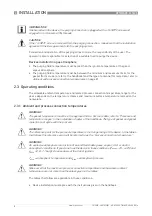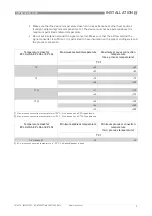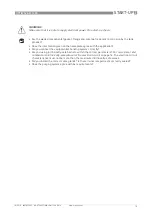
ELECTRICAL CONNECTIONS
3
13
OPTIWAVE-M 7400
www.krohne.com
10/2018 - 4007039501 - AD ATEX OPTIWAVE-M 7400 R01a
3.4 Equipotential bonding system
Connect the device to the equipotential bonding system for the hazardous location.
You can use 2 terminals to connect the device to the equipotential bonding system:
•
a ground connection in the terminal compartment and
•
an external ground terminal adjacent to the cable entries
You can also use the process connection to connect the device to the equipotential bonding
system. Make sure that there is a good electrical connection to the process connection (flange,
thread etc.).
The device electronics are isolated with a rating of 500 V
RMS
.
3.5 How to connect the electrical cables
Refer to the handbook for data about the device terminals.
Cable glands are supplied on customer demand. We recommend that you use a part that has a
degree of ingress protection IP
≥
68. Make sure that the cable gland is sealed.
Obey the instructions that follow:
•
Electrical wires must agree with applicable standards (e.g. EN 60079-14).
•
Use the electrical connection procedure in the Handbook.
•
Put the electrical wires in position and safely attach them to prevent damage. The electrical
wires must also be a sufficient distance from hot surfaces.
•
Make sure that unused electrical wires are safely connected to the ground potential of the
hazardous area. If this is not possible, make sure that each of the unused electrical wires are
safely isolated (other electrical wires, ground etc.) and rated for a test voltage
≥
500 V
RMS
.
•
If it is necessary, make sure the electrical wire insulation gives good protection from
corrosion.
•
Connect only to separate certified, intrinsically-safe circuits. Make sure that the electrical
circuit characteristics are not more than the values that follow.
•
Do not remove more than 6 mm / 0.2
¨
of insulation from the wire.
Figure 3-3: Examples of termInals for the equipotential bonding system
1
Internal terminal
2
External terminal (on the housing)






































